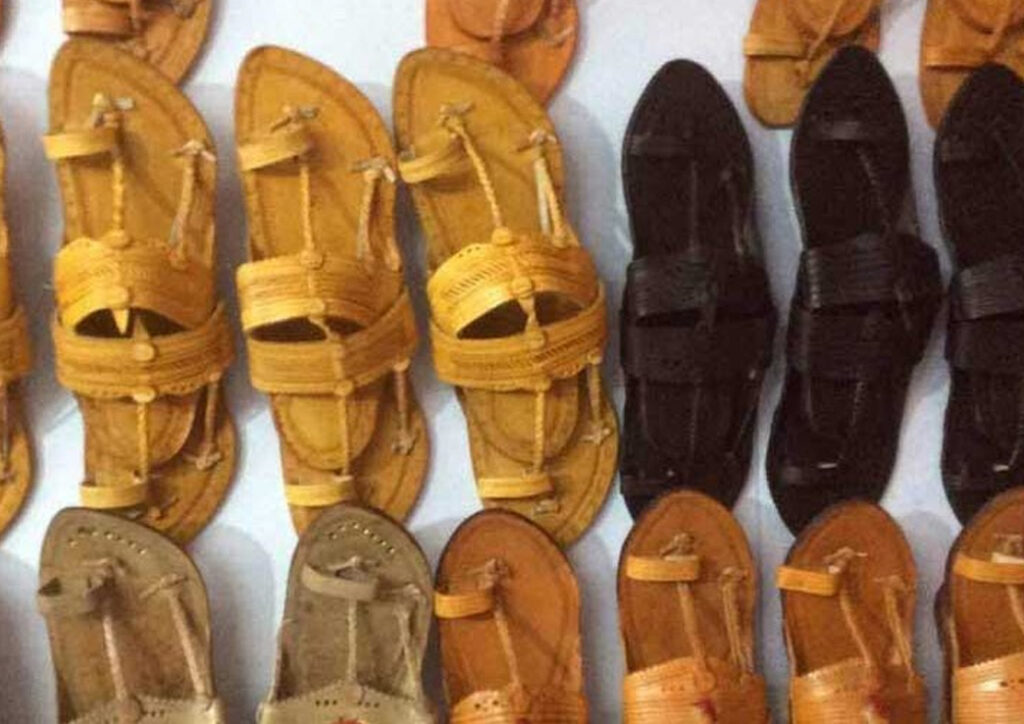Introduction
India is known for its many crafts, textiles, pottery, glass, metal etc. But one unique product that blends craftsmanship with style and artistry, that has stood the test of time is the iconic footwear of India – the Kolhapuri Chappals. The hand-crafted Indian leather slippers that have won hearts all over the world for its sheer simplicity and comfort. The chappals distinctive feature is the sound “Karr-Karr”, which is produced by inserting seeds from the Vichu fruit between two layers of leather
This blog will delve into the history and development of these cherished sandals. Travelling through time and space, we will unlock the world of creativity from where these open-toed, T-strap sandals come from.
Historical Development and Cultural Significance
Let us travel back in time to find the origins of the Kolhapuri chappals. Back into the 13th century India, when the first Kolhapuri chappalss were worn by the people of Maharashtra. The royal patrons like the King of Bijala and his prime minister Basavanna, The Shahu of Kolhapur, all encouraged the Kolhapuri chappals industry to support the local cobblers.
It was known that more than 25 tanning centres were opened and supported during the rule of Rajaram III. The chappals were previously known as Kapashi, Paytaan, Kachkadi, Bakkalnali, and Pukri. The name of the chappals indicates the village where it was made. As centuries passed, Kolhapuri Chappals evolved from humble footwear worn by farmers and shepherds to a symbol of status and tradition.
Kolhapuri chappals are an integral part of the traditional Maharashtrian culture and is seen as s significant part of festive wears like weddings and cultural events. Moreover, it has been known that wearing these soft leather footwear help absorb body heat and sweat, thereby making them beneficial and appropriate for the hot weathers of India.
Not just in India, the Kolhapuri chappals have their fan base in the west too. During the hippie movements of the 60s and the 70s, these leather footwears became very popular in the Unites States. They are popularly known as “toe-ring” sandals due to their unique design which holds the foot with a leather ring around the toe and a strap over the arch of the foot.
Process of Making Kolhapuri Chappals
The craft of making Kolhapuri chappals has remained the same throughout the centuries. Having been handed over through generations, the essence of making a Kolhapuri pair of chappals has always included intense labour of love. Originally, they were made from tanned buffalo hide, to make them suitable for the heat and mountainous terrain of the Maharashtrian region. It was estimated that it takes up to six weeks to produce one pair of chappals.
Skiving, pattern making, cutting, stitching, finishing, punching and trimming are some of the broader steps involved. And as is with all traditional Indian crafts, these sandals were locally tanned using only vegetable dyes, proving that the ancient Indian craftsman always knew about sustainability and eco-friendly measures.
Modern Relevance & GIS Tag
Though the face of things and raw materials have changes, but what has been untouched is the love that these sandals receive from aficionados. With the advent of technology and contemporary design influences, these sandals have adapted to meet the demands of a global audience. From sleek, minimalist designs to vibrant, embellished styles, Kolhapuri Chappals continue to captivate fashion enthusiasts of all ages.
In July 2019 Kolhapuri chappals got a geographical indication tag from the Controller General of Patents, Designs & Trade Marks. An interesting fact about these chappals is that artisans form Karnataka are also involved in making these Kolhapuri chappals, making it another centre for these crafted footwears. A French brand called CHAPPALS exports these traditional sandals in various colors and with a feminine design to France to make it popular in that country.
Contemporary Usage
While sometime ago, these chappals saw a decline in popularity, but in recent time with celebrity endorsement they are gaining their lost popularity amongst the masses. With the encouragement and patronage from designers like Sabyasachi Mukherjee and Payal Singhal, who have reimagined these classic designs for the contemporary consumer and have helped them reconnect to the new consumer base.
With popular brands like Aprajita Toor and Pure Leather Kolhapuri offering a wide range of styles to suit every taste and occasions, these chappals are recapturing the public imagination with providing the public with signature aesthetics with a modern twist.
Conclusion
As we come to conclude this blog post covering a very interesting indigenous craft of India, we are left in awe of this timeless artisanal footwear. The Kolhapuri Chappals are not just mere footwear but a constant reminder of what the human hands can achieve when it comes to artistic excellence with a functional aspect.
So, the next time you stroll down an India street in these chappalss or dance the night away in a wedding wearing these footwear, remember – you are not wearing just a footwear but you’re embracing a centuries-old tradition and making a statement that transcends fashion trends. Please comment in the section below and let us know your favourite memory with these Indian footwears.





























